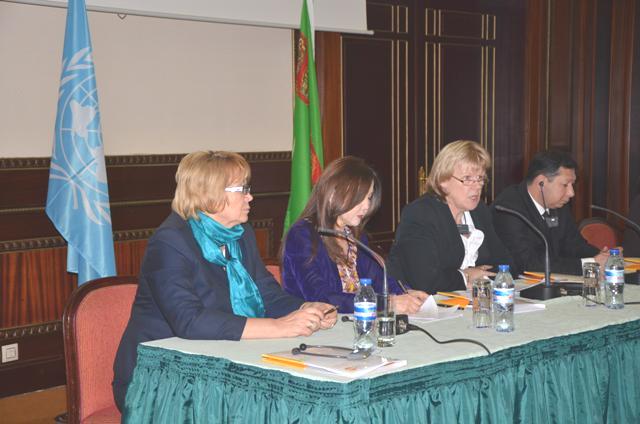The State of World Population 2013 Report titled “Motherhood in childhood: facing the challenge of adolescent pregnancy” was launched in Ashgabat on 22 November at the President Hotel.
The Report was presented at the ceremony, which was attended by the Turkmen national partners, representatives of the UN agencies and international organizations, the diplomatic corps, university professors and students, as well as the civil society and national mass media. The report was also launched globally in more than 100 countries.
Motherhood in childhood is a huge global problem, especially in developing countries, where every year 7.3 million girls under 18 give birth, according to The State of World Population 2013, released last month by UNFPA, the United Nations Population Fund. The Report highlights the main challenges of adolescent pregnancy and its serious impacts on girls’ education, health and long-term employment opportunities, and it provides a new holistic approach to curb this trend and protect girls’ human rights and well-being.
Traditionally, the blame for these pregnancies has been placed on the girls, and efforts to prevent these pregnancies have aimed at changing girls’ behavior. But we can’t solve this problem unless we change the actions of their families, communities and governments, too – asserts the Report.
In her opening remark, Ms. Jacinta Barrins, UN Resident Coordinator and UNFPA Representative stated that UNFPA calls on governments to consider the new perspective and adopt a new comprehensive approach to tackle the challenge of adolescent pregnancy. “The new perspective proposes tearing down the social, economic and geographic barriers to a girl’s access to information and services to enable her to make choices to prevent pregnancy. It is also important to involve boys and help them become part of the solution,” Ms. Barrins said.
Mr. Ashyr Atayev, Deputy Minister of Health and Medical Industry of Turkmenistan, reiterated the importance and relevance of the topic. In his opening statement, he reaffirmed the commitment of the Government of Turkmenistan to the issue and noted the importance of the inter-governmental cooperation and taking up complex measures to address the issue of adolescent pregnancy in the country.
Ms. Lidiya Bardakova, UNFPA Assistant Representative in Russian Federation, gave the global and regional outlook at the issue highlighted in the report. She noted that adolescent pregnancy prevents a girl from realizing her potential and adversely impacts the baby.
During the presentation, Ms. Bardakova stated that the issue of adolescent pregnancy is a health risk. Complications from pregnancy and childbirth are the leading causes of deaths of girls aged between 15 and 19 years in developing countries. Every year, some 70,000 adolescent girls in developing countries die of complications of pregnancy and childbirth, according to the Report. Many teenagers who get pregnant resort to abortion, often under unsafe co nditions. And children born to teenage mothers are more likely to face health problems.
According to the report, adolescent pregnancy is a human rights issue. If a girl becomes pregnant, it is often because her rights were violated. For example, she may lack access to information and services on adolescent reproductive health; she was married illegally as a child; or simply, she was subjected to sexual exploitation. And giving birth as a teenager often leads to further rights violation, with the expulsion from school and other types of rights violation within a community.
The issue of adolescent pregnancy is an economic issue. Giving birth as a teenager dramatically narrows the opportunities a girl has in life. It perpetuates the vicious circle of poverty, lack of education and social exclusion. It is not just mothers and babies that suffer consequences. Children having children also severely impacts communities and nations’ economies.
Ms. Bardakova concluded with the political and programme recommendations the Report issues for the Governments, which aim at eliminating many of the conditions that contribute to adolescent pregnancy by upholding the rights of every girl and empowering her to exercise her rights.
Ms. Maral Ilmamedova, representative of the Ministry of Health and Medical Industry of Turkmenistan, presented the highlights of the work carried out by the Government of Turkmenistan. While Ms. Bardakova stressed the urgency of creating youth-friendly services in all countries, Ms. Ilmamedova responded that “the Government of Turkmenistan is currently in the process of drafting the National Strategy on Child and Adolescent Health, which envisages the creation of such services and further increase in access of youth people to quality information on adolescent reproductive health.”
The Report Launch concluded with the Award Ceremony of the UNFPA Media Competition 2013. Here, UNFPA recognized the winners of the Media Competition on Best coverage of the youth health issues in the national media, which was announced in the beginning of the year.
Journalists of the national media submitted 46 materials covering the issues of youth health – 11 radio reports and 35 articles in print media – including adolescent reproductive health, youth and family planning, reproductive rights, education in the area of youth health, and general coverage of healthy lifestyle among teenagers. Seven media materials published and aired in the national and local media were awarded during the SWOP Report Launch in Ashgabat for quality and in-depth coverage of the topic of adolescent reproductive health.
“Media plays a key role in promoting the issues of youth health, specifically the importance of adolescent reproductive health, among the general population,” said Ms. Bayramgul Garabayeva, UNFPA Assistant Representative in Turkmenistan during the Award Ceremony. “The UNFPA Media Competition allows us to increase the access of youth to quality information and education on adolescent reproductive health. It is also noteworthy that the annual UNFPA Media Competition, which is now a tradition, has already created a professional network of journalists interested in covering the issue of reproductive health.”
For the full SWOP 2013 Report and other resources, please visit: www.unfpa.org/swp
***
UNFPA: Delivering the world where every pregnancy is wanted, every childbirth is safe, and every young person’s potential is fulfilled.
For additional information, please contact:
Ene Tuyliyeva, Advocacy Communication Associate
Tel: 425250
Web: turkmenistan.unfpa.org


